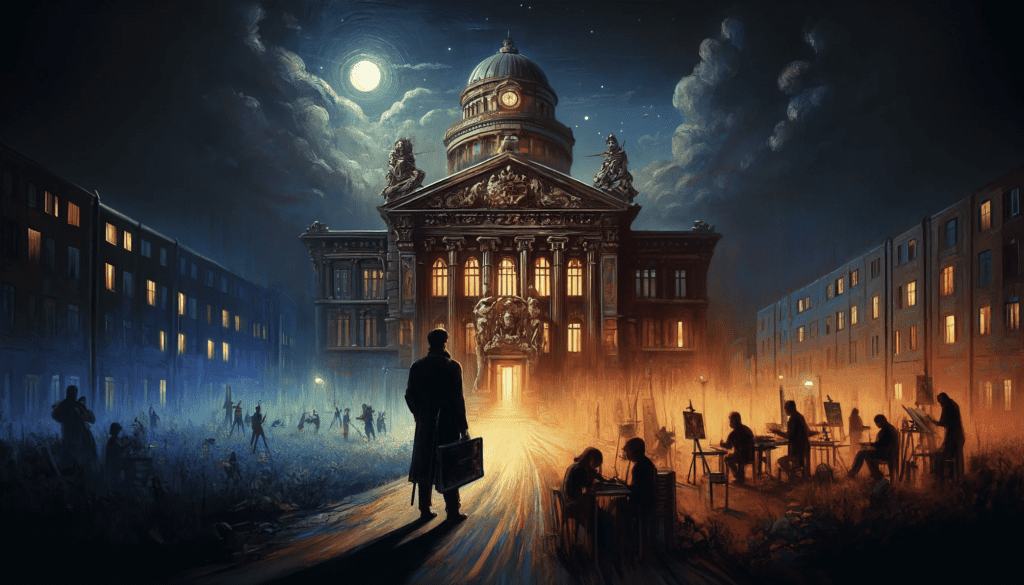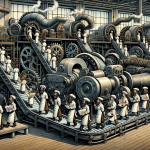
Imagine an artist who, despite having no formal training from a prestigious art school, achieves worldwide acclaim and success. Think of someone like Banksy, whose provocative street art has captured global attention without the backing of an elite institution. This starkly contrasts with the experiences of many graduates from famous art schools, who often find themselves burdened by expectations, debt, and industry pressures. While these degrees can undoubtedly open doors, they also come with significant downsides that are often overlooked.
In this article, we’ll delve into why degrees from famous art schools can sometimes feel like a curse rather than a blessing. We’ll explore the heavy financial burdens that accompany these degrees, the creative limitations imposed by academic environments, and the relentless industry pressures that graduates face. Additionally, we’ll highlight alternative paths to success that don’t involve a degree from a prestigious institution, proving that there are many ways to achieve recognition and fulfillment in the art world.
Understanding these issues is crucial for aspiring artists and their families as they make decisions about education and careers. By examining the challenges associated with famous art school degrees, we can better appreciate the diverse and often unconventional paths that many successful artists have taken. So, let’s dive into the financial, creative, and professional realities of holding a degree from a renowned art school.
As we explore this topic, consider the broader implications for the art world and the importance of redefining success. Are famous art schools truly the best path for every artist, or are there other ways to nurture creativity and achieve career goals? Let’s uncover the complexities behind the allure of prestigious art schools and challenge the assumptions that come with them.
Financial Burden
The allure of a degree from a top art school often comes with a hefty price tag. Tuition at these institutions can be astronomical, with some schools charging upwards of $50,000 per year. When you factor in additional costs like supplies, housing, and fees, the total expense can easily exceed $200,000 by the time you graduate. For many students, this means taking on substantial loans, leading to a mountain of debt that can take decades to pay off.
Student debt is a reality that haunts many art school graduates. Imagine starting your career with the pressure of having to make significant monthly payments while trying to establish yourself in a notoriously underpaid field. Personal stories abound of artists who struggle with this burden, feeling trapped by their financial obligations. This debt can stifle creativity and limit opportunities, as graduates may be forced to take on unrelated jobs just to make ends meet.
The return on investment for a degree from a famous art school is often questionable. While some graduates do find lucrative opportunities, many others face a long and uncertain path to financial stability. Entry-level jobs in the arts typically offer modest salaries, making it challenging to cover basic living expenses, let alone pay off student loans. The long-term financial impact of such debt can hinder an artist’s ability to take risks, experiment, and fully dedicate themselves to their craft.
Economic inequality is another significant issue perpetuated by the high cost of art school. Talented individuals from less affluent backgrounds may find it impossible to afford tuition without taking on unsustainable debt. This creates a barrier to entry, ensuring that the student body at these prestigious institutions often lacks diversity. As a result, the art world misses out on a wealth of perspectives and voices that could enrich the creative landscape.
Creative Limitations
Art schools are often seen as bastions of creativity, yet they can impose significant limitations on artistic expression. Institutional influence can be profound, with curriculums that emphasize specific styles, techniques, and norms. While this structure can provide valuable training, it can also constrain students, pushing them to conform to established expectations rather than encouraging genuine innovation. Many artists leave school feeling that their true creative potential has been stifled by academic rigidity.
The pressure to conform is a pervasive issue in art schools. Students frequently face expectations from both peers and faculty to adhere to certain trends or styles that are deemed acceptable or fashionable. This environment can make it difficult for artists to develop their unique voice, as the fear of criticism or rejection can lead them to create work that aligns with prevailing tastes rather than their own vision. This conformity can stifle originality and result in a homogenized art scene.
A lack of diverse perspectives is another drawback of many prestigious art schools. Despite their reputations, these institutions can often be surprisingly homogeneous, both in terms of their student body and the art they produce. This lack of diversity limits the range of experiences and viewpoints that are represented, resulting in a narrower artistic discourse. True innovation thrives on a variety of influences and backgrounds, making it essential for the art world to embrace and nurture diverse voices.
Burnout and disillusionment are common among art school graduates, who often face intense pressure to perform and succeed. The competitive nature of these programs can take a toll on mental health, leading to feelings of exhaustion and inadequacy. Personal accounts from graduates reveal stories of burnout, where the joy of creating is overshadowed by the relentless drive to meet external standards. This disillusionment can dampen an artist’s passion and commitment to their work, leading some to abandon their artistic pursuits altogether.
Industry Pressures
Graduating from a prestigious art school can set incredibly high expectations, both from the industry and from oneself. The assumption that a degree from a top school guarantees success can create immense pressure to meet these unrealistic expectations. Many graduates find themselves struggling to live up to the hype, facing significant stress and anxiety as they navigate their careers. This pressure can be debilitating, impacting mental health and overall well-being.
Networking and gatekeeping are significant issues in the art world, often exacerbated by the exclusivity of famous art schools. While these institutions can provide valuable connections, they can also create insular networks that are difficult to penetrate. Stories of talented artists being excluded from opportunities because they lack the “right” connections are all too common. This gatekeeping can stifle creativity and limit the diversity of voices in the art world, perpetuating a cycle of elitism and exclusion.
Market saturation is another challenge for graduates of prestigious art schools. With so many talented individuals vying for a limited number of opportunities, standing out in a crowded job market can be incredibly difficult. This oversupply of graduates can lead to intense competition, making it harder for individual artists to gain recognition and secure meaningful work. The pressure to differentiate oneself in such a competitive environment can be overwhelming and disheartening.
Exploitation and unstable jobs are rampant in the art industry, with many graduates finding themselves in precarious employment situations. Unpaid internships and low-paying jobs are common, making it difficult to achieve financial stability. The gig economy and freelance work, which are prevalent in the arts, can also contribute to job insecurity and stress. For many artists, the reality of the job market is a far cry from the idealized vision of success promoted by prestigious art schools.
Alternative Paths to Success
The notion that a degree from a famous art school is the only path to success is a myth. Many self-taught artists have achieved remarkable success without formal education. These individuals have taken advantage of resources like online tutorials, workshops, and community classes to hone their skills. Success stories of self-taught artists, such as Jean-Michel Basquiat, highlight the potential to thrive outside traditional educational frameworks. These artists often bring fresh perspectives and innovative approaches to their work, unencumbered by academic constraints.
Community and independent learning offer valuable alternatives to formal art education. Local art communities and online platforms provide spaces for artists to connect, collaborate, and learn from each other. These environments foster a sense of belonging and support that can be just as impactful as the networks found in prestigious art schools. By engaging with diverse sources of inspiration and feedback, artists can develop a well-rounded and unique artistic voice.
Vocational and trade schools present another viable option for aspiring artists. These institutions often focus on practical skills and hands-on experience, providing a more affordable and accessible education. Graduates of vocational schools can enter the job market with a strong foundation in their chosen craft, often without the burden of significant debt. This approach can be particularly beneficial for artists seeking to balance creative fulfillment with financial stability.
Entrepreneurial approaches to art careers are becoming increasingly popular, as artists find new ways to create and market their work independently. The rise of digital platforms and social media has opened up opportunities for artists to reach global audiences and sell their work directly. Examples of successful art entrepreneurs, such as those who launch their own galleries or create online marketplaces, demonstrate the potential for artists to forge their own paths. By embracing an entrepreneurial mindset, artists can take control of their careers and achieve success on their own terms.
Conclusion
The rise and fall of artist colonies tell a fascinating story of creativity, community, and change. From their origins in the 19th century to their golden age and eventual decline, these colonies have left an indelible mark on the art world. They provided a unique environment where artists could experiment, collaborate, and push the boundaries of artistic expression. The legacy of these colonies can still be seen today in modern artist residencies and collaborative projects, which continue to draw inspiration from the communal and supportive atmosphere of their predecessors.
Reflecting on the enduring allure of artist colonies, it’s clear that the desire for creative community and collaboration remains as strong as ever. In a world that often values individual achievement and competition, the artist colony offers a powerful reminder of the importance of mutual support and shared vision. By looking to the past, contemporary artists and art communities can find valuable lessons on the benefits of working together and fostering a sense of belonging.
What can we learn from the history of artist colonies? Perhaps the most important lesson is the value of community in the creative process. While the circumstances and challenges faced by artists today may be different, the need for connection and collaboration remains constant. By embracing the spirit of the artist colony, modern art communities can create environments that nurture creativity and innovation, ensuring that the legacy of these remarkable enclaves continues to inspire future generations.
As we ponder the future of artist communities, it’s worth considering how we can adapt the principles of the artist colony to meet the needs of contemporary artists. Whether through digital platforms, urban co-living spaces, or rural retreats, the possibilities are endless. The rise and fall of artist colonies may be a story from the past, but their influence and inspiration are very much alive today. So, let’s celebrate their legacy and look forward to the new forms of creative community that lie ahead.




